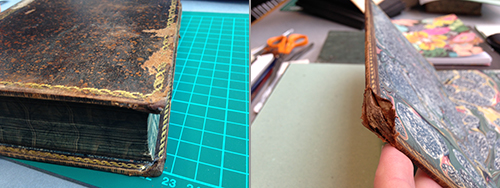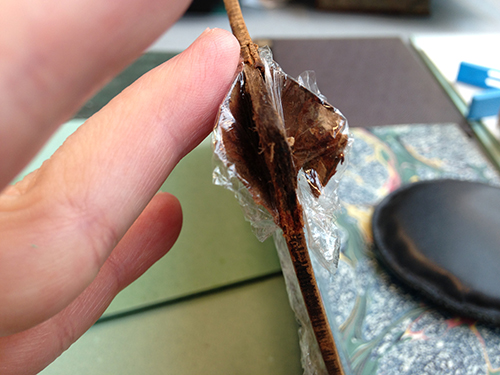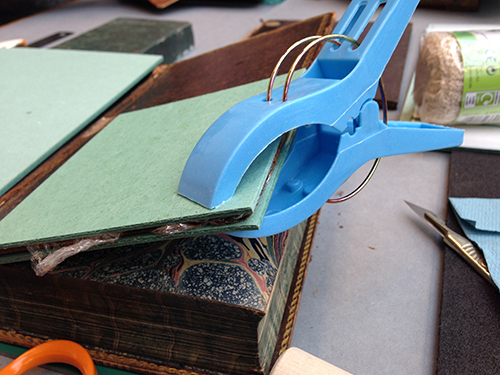Book Conservation Skills for Paper Conservators
Within our collections, we have various books that are part of the archives we hold. Most notably FHK Henrion‘s library from his studio, which includes books in several languages on a variety of different subjects. Obviously books present a whole different conservation and preservation challenge, so…
… back in August this year I applied for a Continuing Professional Development grant from a funding pot held by the Anna Plowden Trust / Clothworkers’ Foundation for awards towards CPD for Conservation Professionals. In September I received an email with a decision that my application had been successful, and that the organisations would help with the cost of attending a ‘Book Conservation Skills for Paper Conservators’ workshop held in the National Library of Scotland in Edinburgh on the 14th and 15th November. In addition to this grant, I was also supported by the Design Archives to attend the workshop – so off I went to bonnie Scotland last week to learn!
First I must confess I arrived at this workshop with next to no knowledge of book conservation processes. I have a basic understanding of bookbinding techniques and some idea about the different types of bindings out there, but have never attempted or discussed book conservation in any shape or form. To be completely honest with you, the thought of it has always utterly terrified me as I have always felt there were simply too many things to consider when it came to the treatment/conservation/preservation of books.
We were a group of 10 eager people from various institutions from all ends of the country with varying professional backgrounds, including a Masters student from Cardiff University and a lady who came all the way from Kuwait to attend the workshop. The course was led by freelance Book Conservator Caroline Scharfenberg ACR.
We began by Caroline running us through a condensed history of bookbinding, giving us a general idea of the timeline for different types of bindings and materials, as well as the vocabulary used by binders and adopted by conservators. We went through the different types of damage you might come across including physical, biological, chemical and mechnical. We also talked about the different tools, materials, techniques, handling and appropriate ethical considerations to think about prior to any ‘action’.
We were given a selection of books from the National Library of Scotland’s collections to choose from to assess. We talked through what an assessment and a treatment plan should consist of whether this was done for an individual volume or a collection of books. Caroline shared with us her own documentation as an example from which we could create ones suitable for our own and/or our institutions’ needs. The most eye-opening thing in relation to the documentation process was to be given parts of Robert Espinosa’s structure outline for book description documentation – I am sure you would agree, this is rather extensive! The book cover structure and its text block always need to be considered separately with any treatment plans, making the process twice as difficult – or fun, if you’re that way inclined!
I wanted to share with you just one of the processes we went through at the workshop: consolidation and stabilisation of a damaged corner. The book I was working on from the Library’s collections was entitled ‘Pinkerton’s Enquiry into the History of Scotland Preceding 1056, Vol. 1’.
The process started by assessing the damage to the text block and the covers and listing all visible damage carefully, while documenting the original state of the book with photographs. All damages listed needed to be analysed and explained in terms of how they affect the book as a whole. It then needs to be thought out if treatment is absolutely necessary and what the alternatives might be. The final decision on how to proceed needs to be a joint one by all involved – this will lead to a better understanding of the processes by everyone. The exchange of knowledge also allows, and leads into, better treatment decisions.
Below on the left you can see the original condition of the book cover and corner in question. By following instructions from Caroline’s demonstrations, the corner leather and book board were cut with a scalpel and lifted. This is done by going about 5mm beyond the extent of the damage. The book board inside was sliced inwards in three places to enable its consolidation.
After lifting the corner, the book cover leather needed to be consolidated with Klucel G, also known by its rather less fetching name of hydroxypropylcellulose. Klucel G is a consolidant which forms a gel and is used by painting it on damaged areas with a brush. The lifted leather corners were painted with Klucel G with a thin blotter to separate it out from the text block. This was left to air-dry for around half an hour. When the Klucel G has dried, pieces of cling film were placed undeneath the leather to screen it off from the board. The next step was to use a 10% wheat starch paste with a thick consistency to consolidate the board (image below).
The paste is worked into the board and brushed in as far as the board is open to reach all the nooks and crannies. It looked very gloopy (and a tad scary!) at this point, but this is then left as it is between 3-10 minutes – with care taken to not get any of the paste on the leather. After this, the boards got pushed together any excess paste was wiped off while shaping the corner back to its original shape.
This gets clamped down anywhere from 10 minutes to an hour with the cling film still in place to avoid contact between the leather and the wheat starch paste. Once the paste has soaked into the board thoroughly, the corner was left to air-dry for a few hours.
When fully dried, the leather and the board were again re-united by using EVA glue (ethylene-vinyl acetate) and left to dry thoroughly for an hour or so, first with clamps and then without. And there we have it – a stabilised book corner! Again I must point out the time conservation treatments can take: to consolidate one corner of a book, including all the drying times, can take over 5 hours.
It was interesting to think and discuss the ways in which book collectors, and ‘everyday book users’, view books: what matters the most is the content of the book with the bindings coming in second. The conservation perspective is to think of the book strucure being a part of the information contained within a book. I find the difference between these points of views fascinating and it is something I come across on a day to day basis at work too – the researcher being only interested in the content when my focus is mostly the condition of the paper on which the information sits. I can now, perhaps with slightly calmed nerves about the processes, extend this to include books.










